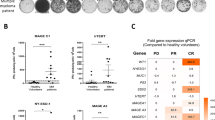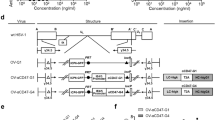Abstract
Neutralizing antiviral antibodies (Abs) can hinder systemic virotherapy. Here, we used activated T cells as carriers to deliver oncolytic measles viruses (MV) to multiple myeloma xenografts in the presence of anti-MV antibodies (Abs). Virus-infected T cells expressing measles H/F fusogenic envelope glycoproteins could efficiently transfer MV infection by heterofusion, even after exposure to virus-inactivating anti-MV antisera. Severe-combined immunodeficiency (SCID) mice bearing subcutaneous or disseminated human myeloma xenografts were given MV-luciferase (MV-Luc) or MV-Luc-infected T cells intravenously. Indium111 labeling indicated that 1–2% of the virus-infected T cells trafficked to tumors. Preinfected T cells fused with tumor cells in vivo and transferred MV-Luc to tumor xenografts where intratumoral viral spread was monitored non-invasively using bioluminescent imaging. In mice passively immunized with high titers of measles immune serum, intravenous virus and cell delivery were both inhibited. Decreasing the amount of measles immune serum given to mice permitted tumor infection by virus-infected T cells and cell-free virus. In conclusion, virus-loaded T cells may facilitate systemic measles virotherapy in the presence of antiviral Abs and they warrant further investigation as potential MV cell carriers.
This is a preview of subscription content, access via your institution
Access options
Subscribe to this journal
Receive 12 print issues and online access
$259.00 per year
only $21.58 per issue
Buy this article
- Purchase on Springer Link
- Instant access to full article PDF
Prices may be subject to local taxes which are calculated during checkout





Similar content being viewed by others
References
Rajkumar SV . Novel approaches to the management of myeloma. Oncology (Williston Park) 2005; 19: 621–625.
Russell SJ . Replicating vectors for cancer therapy: a question of strategy. Semin Cancer Biol 1994; 5: 437–443.
Thorne SH, Hermiston T, Kirn D . Oncolytic virotherapy: approaches to tumor targeting and enhancing antitumor effects. Semin Oncol 2005; 32: 537–548.
Nakamura T, Russell SJ . Oncolytic measles viruses for cancer therapy. Expert Opin Biol Ther 2004; 4: 1685–1692.
Nakamura T, Peng KW, Harvey M, Greiner S, Lorimer IA, James CD et al. Rescue and propagation of fully retargeted oncolytic measles viruses. Nat Biotechnol 2005; 23: 209–214.
Peng KW, Facteau S, Wegman T, O’Kane D, Russell SJ . Non-invasive in vivo monitoring of trackable viruses expressing soluble marker peptides. Nat Med 2002; 8: 527–531.
Dingli D, Peng KW, Harvey ME, Greipp PR, O’Connor MK, Cattaneo R et al. Image-guided radiovirotherapy for multiple myeloma using a recombinant measles virus expressing the thyroidal sodium iodide symporter. Blood 2004; 103: 1641–1646.
Peng KW, Ahmann GJ, Pham L, Greipp PR, Cattaneo R, Russell SJ . Systemic therapy of myeloma xenografts by an attenuated measles virus. Blood 2001; 98: 2002–2007.
Peng KW, TenEyck CJ, Galanis E, Kalli KR, Hartmann LC, Russell SJ . Intraperitoneal therapy of ovarian cancer using an engineered measles virus. Cancer Res 2002; 62: 4656–4662.
Phuong LK, Allen C, Peng KW, Giannini C, Greiner S, TenEyck CJ et al. Use of a vaccine strain of measles virus genetically engineered to produce carcinoembryonic antigen as a novel therapeutic agent against glioblastoma multiforme. Cancer Res 2003; 63: 2462–2469.
Dingli D, Peng KW, Harvey ME, Vongpunsawad S, Bergert ER, Kyle RA et al. Interaction of measles virus vectors with Auger electron emitting radioisotopes. Biochem Biophys Res Commun 2005; 337: 22–29.
Fisher KD, Stallwood Y, Green NK, Ulbrich K, Mautner V, Seymour LW . Polymer-coated adenovirus permits efficient retargeting and evades neutralising antibodies. Gene Therapy 2001; 8: 341–348.
Croyle MA, Chirmule N, Zhang Y, Wilson JM . PEGylation of E1-deleted adenovirus vectors allows significant gene expression on readministration to liver. Hum Gene Ther 2002; 13: 1887–1900.
Thorne SH, Negrin RS, Contag CH . Synergistic antitumor effects of immune cell-viral biotherapy. Science 2006; 311: 1780–1784.
Harrington K, Alvarez-Vallina L, Crittenden M, Gough M, Chong H, Diaz RM et al. Cells as vehicles for cancer gene therapy: the missing link between targeted vectors and systemic delivery? Hum Gene Ther 2002; 13: 1263–1280.
Culver KW, Ram Z, Wallbridge S, Ishii H, Oldfield EH, Blaese RM . In vivo gene transfer with retroviral vector-producer cells for treatment of experimental brain tumors. Science 1992; 256: 1550–1552.
Ram Z, Culver KW, Oshiro EM, Viola JJ, DeVroom HL, Otto E et al. Therapy of malignant brain tumors by intratumoral implantation of retroviral vector-producing cells. Nat Med 1997; 3: 1354–1361.
Coukos G, Makrigiannakis A, Kang EH, Caparelli D, Benjamin I, Kaiser LR et al. Use of carrier cells to deliver a replication-selective herpes simplex virus-1 mutant for the intraperitoneal therapy of epithelial ovarian cancer. Clin Cancer Res 1999; 5: 1523–1537.
Raykov Z, Balboni G, Aprahamian M, Rommelaere J . Carrier cell-mediated delivery of oncolytic parvoviruses for targeting metastases. Int J Cancer 2004; 109: 742–749.
Jevremovic D, Gulati R, Hennig I, Diaz RM, Cole C, Kleppe L et al. Use of blood outgrowth endothelial cells as virus-producing vectors for gene delivery to tumors. Am J Physiol Heart Circ Physiol 2004; 287: H494–H500.
Garcia-Castro J, Martinez-Palacio J, Lillo R, Garcia-Sanchez F, Alemany R, Madero L et al. Tumor cells as cellular vehicles to deliver gene therapies to metastatic tumors. Cancer Gene Ther 2005; 12: 341–349.
Cole C, Qiao J, Kottke T, Diaz RM, Ahmed A, Sanchez-Perez L et al. Tumor-targeted, systemic delivery of therapeutic viral vectors using hitchhiking on antigen-specific T cells. Nat Med 2005; 11: 1073–1081.
Komarova S, Kawakami Y, Stoff-Khalili MA, Curiel DT, Pereboeva L . Mesenchymal progenitor cells as cellular vehicles for delivery of oncolytic adenoviruses. Mol Cancer Ther 2006; 5: 755–766.
Griffin D . Measles virus. In: Knipe D, Howley P, Griffin D, Lamb R, Martin M, Roizman B, Strauss S (eds). Field's Virology. Lippincott Williams & Wilkins: Philadelphia, 2001, pp 1401.
Dudley ME, Rosenberg SA . Adoptive-cell-transfer therapy for the treatment of patients with cancer. Nat Rev Cancer 2003; 3: 666–675.
Riviere I, Sadelain M, Brentjens RJ . Novel strategies for cancer therapy: the potential of genetically modified T lymphocytes. Curr Hematol Rep 2004; 3: 290–297.
Ratnam S, Gadag V, West R, Burris J, Oates E, Stead F et al. Comparison of commercial enzyme immunoassay kits with plaque reduction neutralization test for detection of measles virus antibody. J Clin Microbiol 1995; 33: 811–815.
Shih IM, Torrance C, Sokoll LJ, Chan DW, Kinzler KW, Vogelstein B . Assessing tumors in living animals through measurement of urinary beta-human chorionic gonadotropin. Nat Med 2000; 6: 711–714.
Chen RT, Markowitz LE, Albrecht P, Stewart JA, Mofenson LM, Preblud SR et al. Measles antibody: reevaluation of protective titers. J Infect Dis 1990; 162: 1036–1042.
Watts A, Foley A, Awwad M, Treter S, Lambrigts D, Buhler L et al. Plasma perfusion by apheresis through a gal immunoaffinity column successfully depletes anti-Gal antibody: experience with 275 aphereses in baboons. Transplant Proc 2000; 32: 860.
Robertson JD, Nagesh K, Jowitt SN, Dougal M, Anderson H, Mutton K et al. Immunogenicity of vaccination against influenza, Streptococcus pneumoniae and Haemophilus influenzae type B in patients with multiple myeloma. Br J Cancer 2000; 82: 1261–1265.
Adams GP, Schier R, McCall AM, Simmons HH, Horak EM, Alpaugh RK et al. High affinity restricts the localization and tumor penetration of single-chain fv antibody molecules. Cancer Res 2001; 61: 4750–4755.
Nanan R, Chittka B, Hadam M, Kreth HW . Measles virus infection causes transient depletion of activated T cells from peripheral circulation. J Clin Virol 1999; 12: 201–210.
Gough M, Crittenden M, Thanarajasingam U, Sanchez-Perez L, Thompson J, Jevremovic D et al. Gene therapy to manipulate effector T cell trafficking to tumors for immunotherapy. J Immunol 2005; 174: 5766–5773.
Kershaw MH, Teng MW, Smyth MJ, Darcy PK . Supernatural T cells: genetic modification of T cells for cancer therapy. Nat Rev Immunol 2005; 5: 928–940.
Tatsuo H, Ono N, Tanaka K, Yanagi Y . SLAM (CDw150) is a cellular receptor for measles virus. Nature 2000; 406: 893–897.
Ong HT, Timm MM, Greipp PR, Witzig TE, Dispenzieri A, Russell SJ et al. Oncolytic measles virus targets high CD46 expression on multiple myeloma cells. Exp Hematol 2006; 34: 713–720.
Acknowledgements
This work was supported by the JARI Foundation for Myeloma Research and the Mayo Foundation.
Author information
Authors and Affiliations
Corresponding author
Rights and permissions
About this article
Cite this article
Ong, H., Hasegawa, K., Dietz, A. et al. Evaluation of T cells as carriers for systemic measles virotherapy in the presence of antiviral antibodies. Gene Ther 14, 324–333 (2007). https://doi.org/10.1038/sj.gt.3302880
Received:
Revised:
Accepted:
Published:
Issue Date:
DOI: https://doi.org/10.1038/sj.gt.3302880
Keywords
This article is cited by
-
Carrier Cells for Delivery of Oncolytic Measles Virus into Tumors: Determinants of Efficient Loading
Virologica Sinica (2018)
-
Oncolytic virotherapy as an immunotherapeutic strategy for multiple myeloma
Blood Cancer Journal (2017)
-
Vaccine platform recombinant measles virus
Virus Genes (2017)
-
A novel, polymer-coated oncolytic measles virus overcomes immune suppression and induces robust antitumor activity
Molecular Therapy - Oncolytics (2016)
-
Oncolytic virotherapy for urological cancers
Nature Reviews Urology (2016)



